Blood Everywhere A Case Study in Blood An

Blood Everywhere: A Case Study in Blood An ambulance arrives at the scene of an automobile accident, having been summoned by an invehicle security system. What the emergency personnel find is like a scene from a horror film. Maggie Silvers, the apparent driver of the car, is sitting, slumped next to the vehicle, with blood covering her shirt and hands. Her car has clearly hit a tree: a branch is sticking into the driver’s window, and the airbag has been deployed. Maggie looks dazed, and as the paramedics approach she says with a mixture of panic and relief, “There’s blood everywhere!” Maggie is only semi-lucid as she babbles on about pushing out the broken glass in her car window. Maggie, a 48 -year-old woman, is, indeed, bleeding profusely from multiple left-arm cuts and an especially deep laceration on her left upper arm. The paramedics stop the bleeding and move her quickly to the ambulance, after noting no other apparent injury. Her systolic blood pressure is 80 mm Hg (low), and her diastolic is not audible (too low to hear). Her heart rate is 122 bpm (very rapid), and her skin is pale and clammy, indicating peripheral vasoconstriction (narrowing of her blood vessels, particularly in the skin) and circulatory shock-like signs. On the way to the hospital, a paramedic begins transfusing normal saline solution (NSS; water with some Na. Cl, similar to body fluids, given directly into her vein). A fast hematocrit (HCT) test upon Maggie’s arrival to the emergency department (ED) indicates that her HCT is low, but normal. Several vials of Maggie’s blood are also sent to the lab for blood tests and typing. Two liters of NSS are transfused over the next hour while the ED physician sutures her deepest, left-upper-arm laceration. Despite no further bleeding since the paramedics treated her at the scene, Maggie’s next HCT, tested one hour after the original HCT, drops to below normal. Aside from her present health problem, Maggie is otherwise healthy. She is admitted to the hospital for overnight observation. © 2015 Pearson Education, Inc.

An Introduction to Blood and the Cardiovascular System • The Cardiovascular System consists of: • A pump (the heart) • A conducting system (blood vessels) • A fluid medium (blood) • Is specialized fluid of connective tissue • Contains cells suspended in a fluid matrix © 2015 Pearson Education, Inc.

19 -1 Physical Characteristics of Blood • Important Functions of Blood • Transportation of dissolved substances (to and from cells) • Regulation of p. H and ions • Restriction of fluid losses at injury sites • Defense against toxins and pathogens • Stabilization of body temperature © 2015 Pearson Education, Inc.

19 -1 Physical Characteristics of Blood • Whole Blood • Plasma • Fluid consisting of: • Water • Dissolved plasma proteins • Other solutes • Formed elements • All cells and solids © 2015 Pearson Education, Inc.

Figure 19 -1 The Composition of Whole Blood (Part 3 of 8). 7% Plasma 55% Plasma Proteins Other Solutes (Range 46– 63%) Water Formed Elements 45% (Range 37– 54%) Platelets 1% 92% <. 1% White Blood Cells Red Blood Cells <. 1% 99. 9% © 2015 Pearson Education, Inc.

19 -1 Physical Characteristics of Blood • Three Types of Formed Elements 1. Red blood cells (RBCs) or erythrocytes • Transport oxygen 2. White blood cells (WBCs) or leukocytes • Part of the immune system 3. Platelets • Cell fragments involved in clotting © 2015 Pearson Education, Inc.

19 -1 Physical Characteristics of Blood • Hemopoiesis • Process of producing formed elements • By myeloid and lymphoid stem cells • Fractionation • Process of separating whole blood for clinical analysis • Into plasma and formed elements © 2015 Pearson Education, Inc.

19 -1 Physical Characteristics of Blood • Three General Characteristics of Blood 1. 38 C (100. 4 F) is normal temperature 2. High viscosity 3. Slightly alkaline p. H (7. 35– 7. 45) © 2015 Pearson Education, Inc.

19 -1 Physical Characteristics of Blood • Blood volume (liters) 7 percent of body weight (kilograms) • Adult male: 5– 6 liters • Adult female: 4– 5 liters © 2015 Pearson Education, Inc.

19 -2 Plasma • The Composition of Plasma • Makes up 50– 60 percent of blood volume • More than 90 percent of plasma is water • Extracellular fluids • Interstitial fluid (IF) and plasma • Materials plasma and IF exchange across capillary walls • Water • Ions • Small solutes © 2015 Pearson Education, Inc.

19 -2 Plasma • Plasma Proteins • Albumins (60 percent) • Globulins (35 percent) • Fibrinogen (4 percent) © 2015 Pearson Education, Inc.

19 -2 Plasma • Albumins (60 percent) • Transport substances such as fatty acids, thyroid hormones, and steroid hormones • Globulins (35 percent) • Antibodies, also called immunoglobulins • Transport globulins (small molecules): hormonebinding proteins, metalloproteins, apolipoproteins (lipoproteins), and steroid-binding proteins • Fibrinogen (4 percent) • Molecules that form clots and produce long, insoluble strands of fibrin © 2015 Pearson Education, Inc.

19 -2 Plasma • Serum • Liquid part of a blood sample • In which dissolved fibrinogen converts to solid fibrin • How can we isolate plasma from cells in whole blood? • How can we isolate serum? • If cells need to be analyzed in whole blood, how should the blood be handled? © 2015 Pearson Education, Inc.

Figure 29 -1 The composition of blood. Plasma 55% Constituent Major Functions Water Solvent for carrying other substances; absorbs heat Salts (electrolytes) Sodium Potassium Calcium Magnesium Chloride Bicarbonate Plasma proteins Albumin Fibrinogen Globulins Formed elements 45% Number (per mm 3 of blood) Cell type Erythrocytes (red blood cells) Osmotic balance, p. H buffering Leukocytes (white blood cells) Osmotic balance Clotting of blood Defense (antibodies) and lipid transport Functions 4 – 6 million Transport oxygen and help transport carbon dioxide 4800 – 10, 800 Defense and immunity Lymphocyte Basophil Eosinophil Substances transported by blood Nutrients (glucose, fatty acids, amino acids, vitamins) Waste products of metabolism (urea, uric acid) Respiratory gases (O 2 and CO 2) Hormones © 2015 Pearson Education, Inc. Monocyte Neutrophil Platelets 150, 000 – 400, 000 Blood clotting

19 -2 Plasma • Other Plasma Proteins • 1 percent of plasma • Changing quantities of specialized plasma proteins • Peptide hormones normally present in circulating blood • Insulin, prolactin (PRL), and the glycoproteins thyroid-stimulating hormone (TSH), folliclestimulating hormone (FSH), and luteinizing hormone (LH) © 2015 Pearson Education, Inc.

19 -3 Red Blood Cells • Red blood cells (RBCs) • Make up 99. 9 percent of blood’s formed elements • Hemoglobin • The red pigment that gives whole blood its color • Binds and transports oxygen and carbon dioxide © 2015 Pearson Education, Inc.

19 -3 Red Blood Cells • Abundance of RBCs • Red blood cell count – the number of RBCs in 1 microliter of whole blood • Male: 4. 5– 6. 3 million • Female: 4. 2– 5. 5 million © 2015 Pearson Education, Inc.

19 -3 Red Blood Cells • Abundance of RBCs • Hematocrit – (packed cell volume, PCV) percentage of RBCs in centrifuged whole blood • Male: 40– 54 • Female: 37– 47 © 2015 Pearson Education, Inc.

19 -3 Red Blood Cells • Abundance of RBCs • Hematocrit – (packed cell volume, PCV) percentage of RBCs in centrifuged whole blood • Male: 40– 54 • Female: 37– 47 © 2015 Pearson Education, Inc.

19 -3 Red Blood Cells • Structure of RBCs • Small and highly specialized discs • Thin in middle and thicker at edge © 2015 Pearson Education, Inc.

Figure 19 -2 c The Anatomy of Red Blood Cells. 0. 45– 1. 16 μm 2. 31– 2. 85 μm 7. 2– 8. 4 μm c © 2015 Pearson Education, Inc. A sectional view of a mature RBC, showing the normal ranges for its dimensions.

19 -3 Red Blood Cells • Three Important Effects of RBC Shape on Function 1. High surface-to-volume ratio • Quickly absorbs and releases oxygen 2. Discs form stacks called rouleaux • Smooth the flow through narrow blood vessels 3. Discs bend and flex entering small capillaries • 7. 8 -µm RBC passes through 4 -µm capillary © 2015 Pearson Education, Inc.

Figure 19 -2 d The Anatomy of Red Blood Cells. Red blood cell (RBC) Rouleau (stacked RBCs) Nucleus of endothelial cell Blood vessels (viewed in longitudinal section) Sectioned capillaries d LM × 1430 When traveling through relatively narrow capillaries, RBCs may stack like dinner plates. © 2015 Pearson Education, Inc.

Figure 19 -2 a The Anatomy of Red Blood Cells. Blood smear a © 2015 Pearson Education, Inc. LM × 477 When viewed in a standard blood smear, RBCs appear as two-dimensional objects, because they are flattened against the surface of the slide.

19 -3 Red Blood Cells • Life Span of RBCs • Lack nuclei, mitochondria, and ribosomes • Means no repair and anaerobic metabolism • Live about 120 days © 2015 Pearson Education, Inc.

19 -3 Red Blood Cells • Hemoglobin (Hb) • Protein molecule that transports respiratory gases • Normal hemoglobin (adult male) • 14– 18 g/d. L whole blood • Normal hemoglobin (adult female) • 12– 16 g/d. L whole blood © 2015 Pearson Education, Inc.

19 -3 Red Blood Cells • Hemoglobin Structure • Complex quaternary structure • Four globular protein subunits • Each with one molecule of heme • Each heme contains one iron ion © 2015 Pearson Education, Inc.

19 -3 Red Blood Cells • Hemoglobin Structure • Iron ions • Associate easily with oxygen (oxyhemoglobin, Hb. O 2) • Dissociate easily from oxygen (deoxyhemoglobin) © 2015 Pearson Education, Inc.

Figure 19 -3 The Structure of Hemoglobin. β chain 1 α chain 1 Heme β chain 2 α chain 2 Hemoglobin molecule © 2015 Pearson Education, Inc. Heme

19 -3 Red Blood Cells • Fetal Hemoglobin • Strong form of hemoglobin found in embryos • Takes oxygen from mother’s hemoglobin © 2015 Pearson Education, Inc.

19 -3 Red Blood Cells • Hemoglobin Function • Carries oxygen • With low oxygen (peripheral capillaries): • Hemoglobin releases oxygen • Binds carbon dioxide and carries it to lungs • Forms carbaminohemoglobin © 2015 Pearson Education, Inc.

19 -3 Red Blood Cells • RBC Formation and Turnover • 1 percent of circulating RBCs wear out per day • About 3 million new RBCs per second • Hemoglobin Conversion and Recycling • Macrophages of liver, spleen, and bone marrow • Monitor RBCs • Engulf RBCs before membranes rupture (hemolyze) © 2015 Pearson Education, Inc.

19 -3 Red Blood Cells • Hemoglobin Conversion and Recycling • Phagocytes break hemoglobin into components • Globular proteins to amino acids • Heme to biliverdin • Iron © 2015 Pearson Education, Inc.

19 -3 Red Blood Cells • Hemoglobin Conversion and Recycling • Hemoglobinuria • Hemoglobin breakdown products in urine due to excess hemolysis in bloodstream • Hematuria • Whole red blood cells in urine due to kidney or tissue damage © 2015 Pearson Education, Inc.

19 -3 Red Blood Cells • Breakdown of Biliverdin • Biliverdin (green) is converted to bilirubin (yellow) • Bilirubin • Is excreted by liver (bile) • Jaundice is caused by bilirubin buildup • Converted by intestinal bacteria to urobilins and stercobilins © 2015 Pearson Education, Inc.

19 -3 Red Blood Cells • Iron Recycling • Iron removed from heme leaving biliverdin • To transport proteins (transferrin) • To storage proteins (ferritin and hemosiderin) © 2015 Pearson Education, Inc.

Figure 19 -4 Recycling of Red Blood Cell Components. Events Occurring in Macrophages Events Occurring in the Red Bone Marrow Macrophages monitor the condition of circulating RBCs, engulfing them before they hemolyze (rupture), or removing Hb molecules, iron, and cell fragments from the RBCs that hemolyze in the bloodstream. Developing RBCs absorb amino acids and Fe 2+ from the bloodstream and synthesize new Hb molecules. RBC formation Macrophages in spleen, Liver, and red bone marrow Fe 2+ transported in bloodstream by transferrin Fe 2+ Heme Amino acids Average life span of RBC is 120 days 90% Biliverdin Bilirubin 10% Bilirubin bound to albumin in bloodstream Old and damaged RBCs In the bloodstream, The rupture of RBCs Is called hemolysis. New RBCs released into bloodstream Hemoglobin that is not phagocytized breaks down, and the alpha and beta chains are eliminated in urine. Kidney Liver Hb Bilirubin Absorbed into the bloodstream Urobilins Excreted in bile Bilirubin © 2015 Pearson Education, Inc. Eliminated In urine Urobilins, stercobilins Events Occurring in the Liver Events Occurring in the Large Intestine Bilirubin released from macrophages binds to albumin and is transported to the liver for excretion in bile. Bacteria convert bilirubin to urobilins and stercobilins. Feces are yellow-brown or brown due to the presence of urobilins and stercobilins in varying proportions. Eliminated in feces Events Occurring in the Kidney The kidneys excrete some hemoglobin, as well as urobilins, which gives urine its yellow color.

19 -3 Red Blood Cells • RBC Production • Erythropoiesis • Occurs only in myeloid tissue (red bone marrow) in adults • Stem cells mature to become RBCs © 2015 Pearson Education, Inc.

Figure 19 -5 Stages of RBC Maturation. RED BONE MARROW Day 1: Proerythroblast Erythroblasts Day 2: Basophilic erythroblast Day 3: Polychromatophilic erythroblast Day 4: Normoblast Ejection of nucleus Days 5– 7: Reticulocyte Enters bloodstream Mature red blood cell © 2015 Pearson Education, Inc.

19 -3 Red Blood Cells • Regulation of Erythropoiesis • Building red blood cells requires: • Amino acids • Iron • Vitamins B 12, B 6, and folic acid • Pernicious anemia • Low RBC production • Due to unavailability of vitamin B 12 © 2015 Pearson Education, Inc.

19 -3 Red Blood Cells • Stimulating Hormones • Erythropoietin (EPO) • Also called erythropoiesis-stimulating hormone • Secreted when oxygen in peripheral tissues is low (hypoxia) • Due to disease or high altitude © 2015 Pearson Education, Inc.

Table 19 -1 RBC Tests and Related Terminology. © 2015 Pearson Education, Inc.

19 -4 Blood Typing • Surface Antigens • Are cell surface proteins that identify cells to immune system • Normal cells are ignored and foreign cells attacked • Blood Types • Are genetically determined • By presence or absence of RBC surface antigens A, B, Rh (or D) © 2015 Pearson Education, Inc.

Blood Everywhere Case Questions (Continued): 5. Why might a physician be reluctant to order a blood transfusion for Maggie, or for any patient for that matter, unless absolutely necessary ? Blood is sometimes (and in some communities) in short supply and should be used only when absolutely necessary. Any blood transfusion carries with it an increased risk of transfusion reaction, though crossmatch screening processes are strict when followed. Though rare (due to thorough screening procedures), blood may carry blood-borne diseases such as hepatitis, human immunodeficiency virus, malaria, etc. Given time, an otherwise healthy body has the ability to replace its own red blood cells. Blood is more expensive to obtain, process, and store than saline solution. 6. Despite no blood transfusion, Maggie’s hematocrit improves by the time she visits her physician for the removal of her sutures a week later. [See multiple choice question 3 for the calculation. ] She is adequately hydrated. Explain the physiological mechanism for the improvement in her hematocrit. When RBCs are lost, HCT drops, and this leads to low oxygen delivery to the tissues (hypoxia). Hypoxia is a signal for the kidney to secrete erythropoietin (EPO). EPO is a hormone that targets red bone marrow to produce more red blood cells, which then restores HCT to normal. This is a negative feedback mechanism. 7. Besides the HCT, what other component of blood could be measured to give a better understanding of oxygen-carrying capacity? Explain your answer. Hemoglobin (Hb) is an index of oxygen-carrying capacity; it is the actual molecule within an RBC that binds oxygen. A normal Hb value for healthy females is 12 -16 g/100 ml of blood, and for healthy males it is 13 -18 g/100 ml. Typically, HCT and Hb are measured and evaluated together to give a fuller hematological understanding. © 2015 Pearson Education, Inc.

19 -4 Blood Typing • Four Basic Blood Types 1. 2. 3. 4. A (surface antigen A) B (surface antigen B) AB (antigens A and B) O (neither A nor B) © 2015 Pearson Education, Inc.

19 -4 Blood Typing • Agglutinogens • Antigens on surface of RBCs • Screened by immune system • Plasma antibodies attack and agglutinate (clump) foreign antigens © 2015 Pearson Education, Inc.

19 -4 Blood Typing • Blood Plasma Antibodies • Type A • Type B antibodies • Type B • Type A antibodies • Type O • Both A and B antibodies • Type AB • Neither A nor B antibodies © 2015 Pearson Education, Inc.

Figure 19 -6 a Blood Types and Cross-Reactions. Type A blood has RBCs with surface antigen A only. Surface antigen A If you have type A blood, your plasma contains anti-B antibodies, which will attack type B surface antigens. a Type B blood has RBCs with surface antigen B only. Type AB blood has RBCs with both A and B surface antigens. Type O blood has RBCs lacking both A and B surface antigens. Surface antigen B If you have type B blood, your plasma contains anti-A antibodies, which will attack type A surface antigens. If you have type AB blood, your plasma has neither anti-A nor anti-B antibodies. Blood type depends on the presence of surface antigens (agglutinogens) on RBC surfaces. The plasma contains antibodies (agglutinins) that will react with foreign surface antigens. © 2015 Pearson Education, Inc. Type O If you have type O blood, your plasma contains both anti-A and anti-B antibodies.

19 -4 Blood Typing • The Rh Factor • Also called D antigen • Either Rh positive (Rh ) or Rh negative (Rh ) • Only sensitized Rh blood has anti-Rh antibodies © 2015 Pearson Education, Inc.

Figure 19 -8 Hemolytic Disease of the Newborn (Part 3 of 6). Rh− mother 1 Rh+ fetus Problems seldom develop during a first pregnancy, because very few fetal cells enter the maternal bloodstream then, and thus the mother’s immune system is not stimulated to produce anti-Rh antibodies. © 2015 Pearson Education, Inc. During First Pregnancy Rh− Maternal blood supply and tissue Rh− Rh− Placenta Rh+ Rh+ Fetal blood supply and tissue Rh+ The most common form of hemolytic disease of the newborn develops after an Rh− woman has carried a Rh+ fetus.

19 -4 Blood Typing • Cross-Reactions in Transfusions • • Also called transfusion reaction Plasma antibody meets its specific surface antigen Blood will agglutinate and hemolyze Occur if donor and recipient blood types not compatible © 2015 Pearson Education, Inc.

Figure 19 -6 b Blood Types and Cross-Reactions. RBC Surface antigens Opposing antibodies Agglutination (clumping) Hemolysis b In a cross-reaction, antibodies react with their target antigens causing agglutination and hemolysis of the affected RBCs. © 2015 Pearson Education, Inc.

19 -4 Blood Typing • Testing for Transfusion Compatibility • Performed on donor and recipient blood for compatibility • Without cross-match, type O is universal donor © 2015 Pearson Education, Inc.

Figure 19 -7 Blood Type Testing. Anti-A Anti-B Anti-D Blood type A+ B+ AB+ O− © 2015 Pearson Education, Inc.

19 -5 White Blood Cells • White Blood Cells (WBCs) • • Also called leukocytes Do not have hemoglobin Have nuclei and other organelles WBC functions • Defend against pathogens • Remove toxins and wastes • Attack abnormal cells © 2015 Pearson Education, Inc.

19 -5 White Blood Cells • WBC Circulation and Movement • Most WBCs in: • Connective tissue proper • Lymphatic system organs • Small numbers in blood • 5000 to 10, 000 per microliter © 2015 Pearson Education, Inc.

19 -5 White Blood Cells • WBC Circulation and Movement • Four Characteristics of Circulating WBCs 1. Can migrate out of bloodstream 2. Have amoeboid movement 3. Attracted to chemical stimuli (positive chemotaxis) 4. Some are phagocytic • Neutrophils, eosinophils, and monocytes © 2015 Pearson Education, Inc.

19 -5 White Blood Cells • Types of WBCs • • • Neutrophils Eosinophils Basophils Monocytes Lymphocytes © 2015 Pearson Education, Inc.
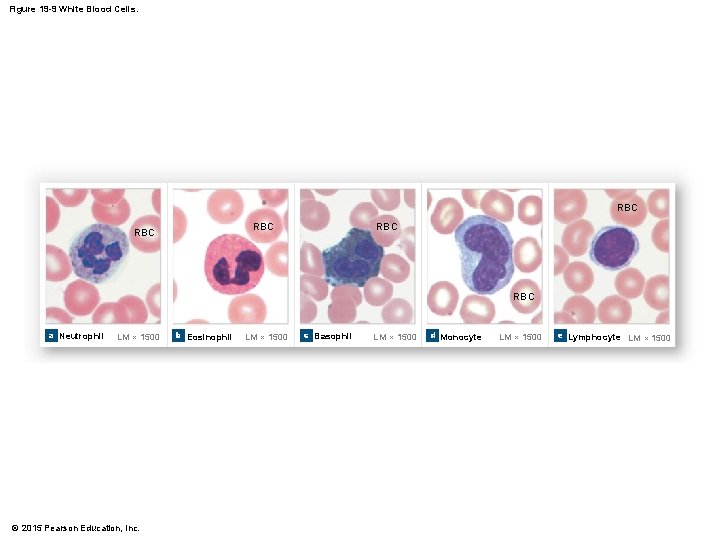
Figure 19 -9 White Blood Cells. RBC RBC RBC a Neutrophil LM × 1500 © 2015 Pearson Education, Inc. b Eosinophil LM × 1500 c Basophil LM × 1500 d Monocyte LM × 1500 e Lymphocyte LM × 1500

19 -5 White Blood Cells • Neutrophils • Also called polymorphonuclear leukocytes • 50– 70 percent of circulating WBCs • Pale cytoplasm granules with: • Lysosomal enzymes • Bactericides (hydrogen peroxide and superoxide) © 2015 Pearson Education, Inc.
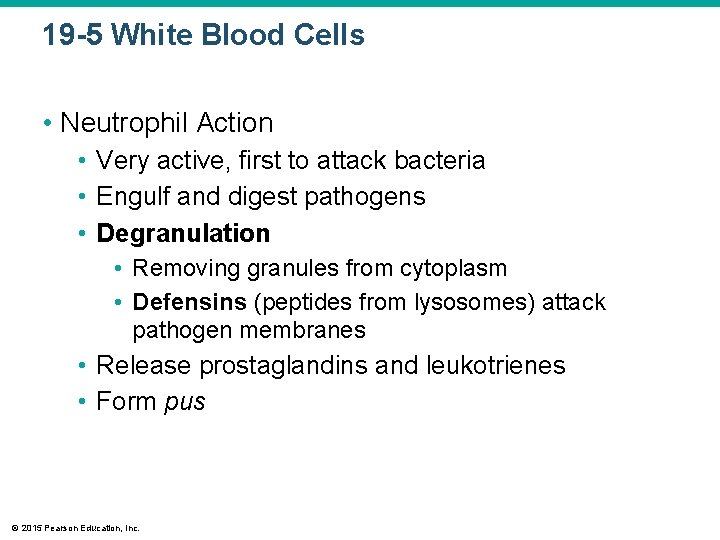
19 -5 White Blood Cells • Neutrophil Action • Very active, first to attack bacteria • Engulf and digest pathogens • Degranulation • Removing granules from cytoplasm • Defensins (peptides from lysosomes) attack pathogen membranes • Release prostaglandins and leukotrienes • Form pus © 2015 Pearson Education, Inc.

Figure 19 -9 a White Blood Cells. RBC a Neutrophil © 2015 Pearson Education, Inc. LM × 1500
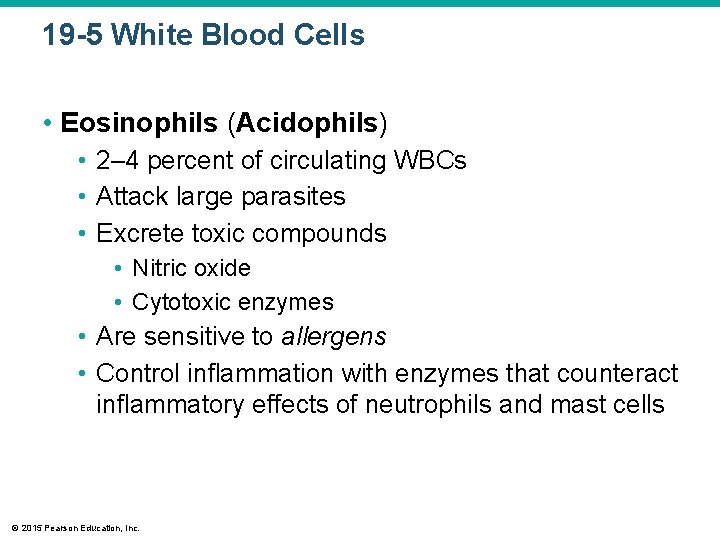
19 -5 White Blood Cells • Eosinophils (Acidophils) • 2– 4 percent of circulating WBCs • Attack large parasites • Excrete toxic compounds • Nitric oxide • Cytotoxic enzymes • Are sensitive to allergens • Control inflammation with enzymes that counteract inflammatory effects of neutrophils and mast cells © 2015 Pearson Education, Inc.
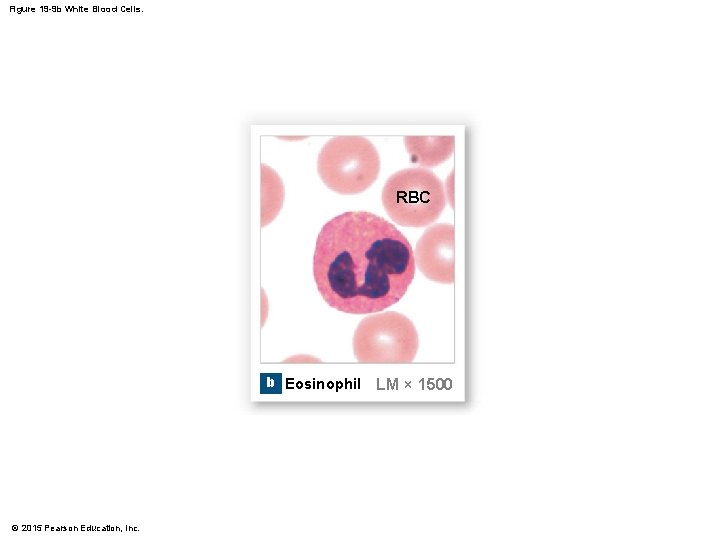
Figure 19 -9 b White Blood Cells. RBC b Eosinophil © 2015 Pearson Education, Inc. LM × 1500
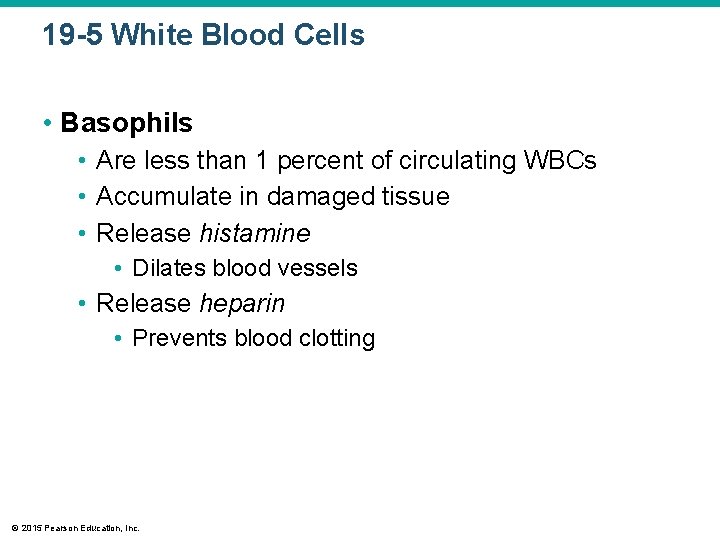
19 -5 White Blood Cells • Basophils • Are less than 1 percent of circulating WBCs • Accumulate in damaged tissue • Release histamine • Dilates blood vessels • Release heparin • Prevents blood clotting © 2015 Pearson Education, Inc.
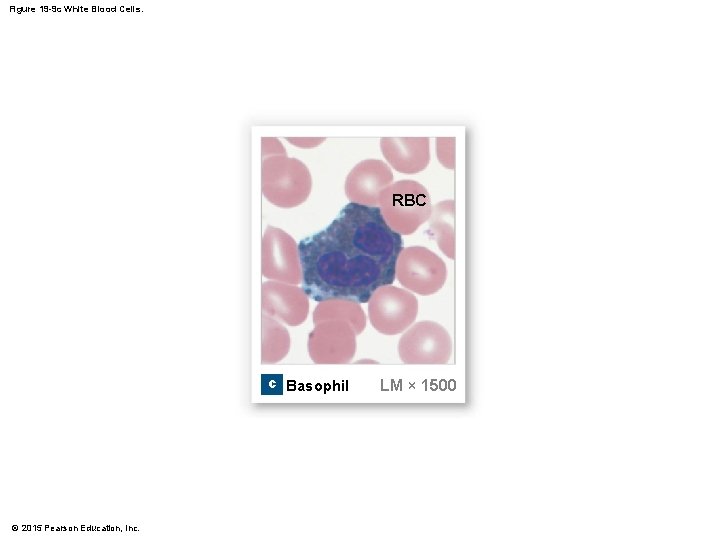
Figure 19 -9 c White Blood Cells. RBC c Basophil © 2015 Pearson Education, Inc. LM × 1500

19 -5 White Blood Cells • Monocytes • 2– 8 percent of circulating WBCs • Are large and spherical • Enter peripheral tissues and become macrophages • Engulf large particles and pathogens • Secrete substances that attract immune system cells and fibroblasts to injured area © 2015 Pearson Education, Inc.

Figure 19 -9 d White Blood Cells. RBC d Monocyte © 2015 Pearson Education, Inc. LM × 1500
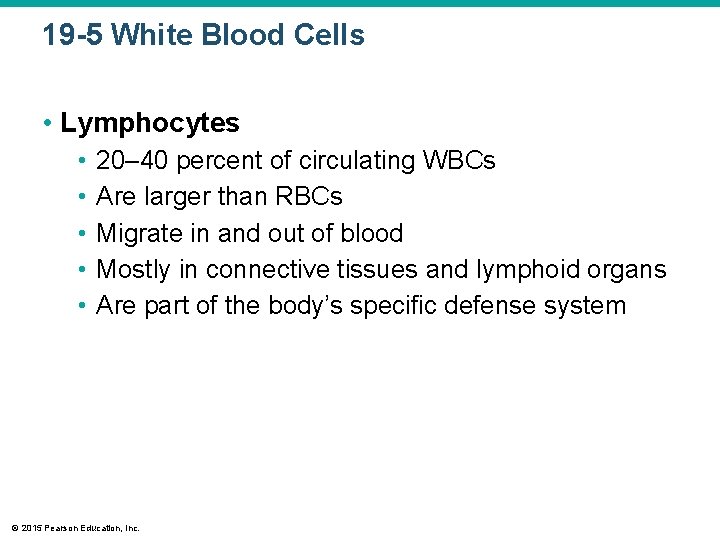
19 -5 White Blood Cells • Lymphocytes • • • 20– 40 percent of circulating WBCs Are larger than RBCs Migrate in and out of blood Mostly in connective tissues and lymphoid organs Are part of the body’s specific defense system © 2015 Pearson Education, Inc.
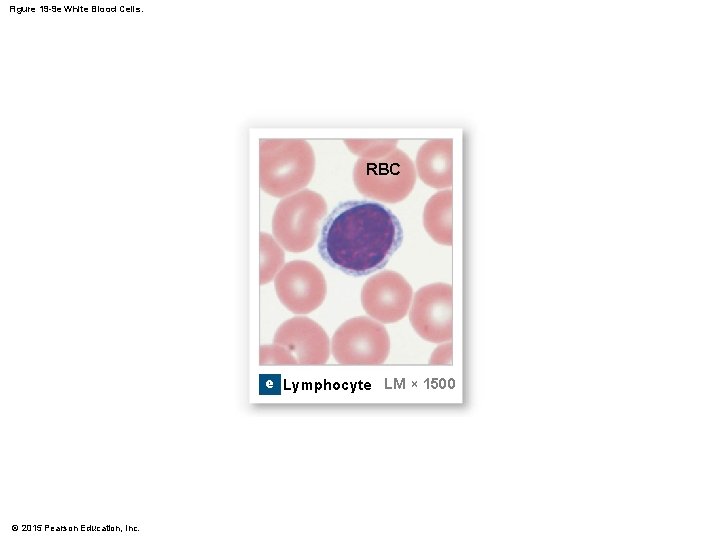
Figure 19 -9 e White Blood Cells. RBC e Lymphocyte LM × 1500 © 2015 Pearson Education, Inc.
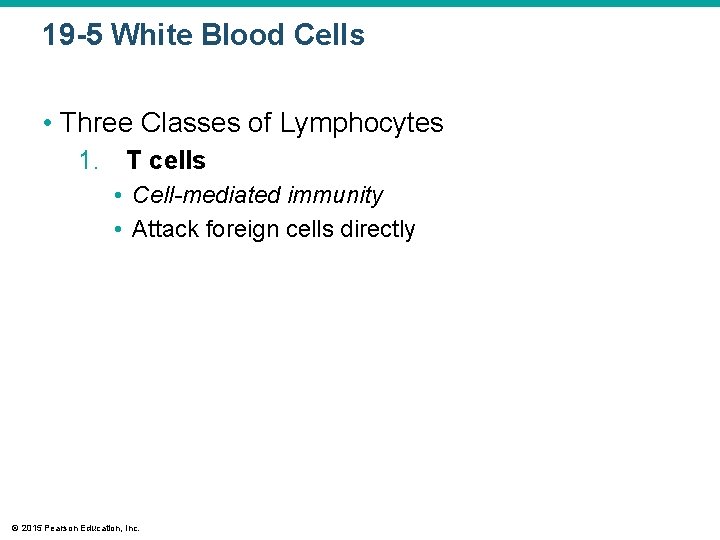
19 -5 White Blood Cells • Three Classes of Lymphocytes 1. T cells • Cell-mediated immunity • Attack foreign cells directly © 2015 Pearson Education, Inc.
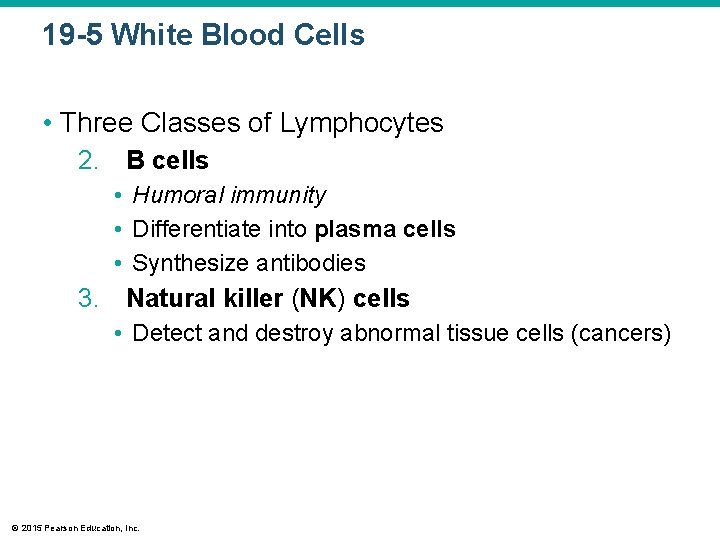
19 -5 White Blood Cells • Three Classes of Lymphocytes 2. B cells • Humoral immunity • Differentiate into plasma cells • Synthesize antibodies 3. Natural killer (NK) cells • Detect and destroy abnormal tissue cells (cancers) © 2015 Pearson Education, Inc.
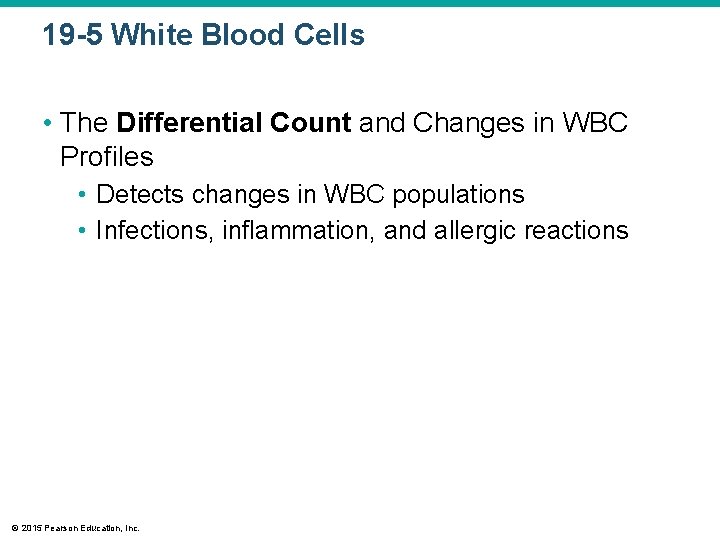
19 -5 White Blood Cells • The Differential Count and Changes in WBC Profiles • Detects changes in WBC populations • Infections, inflammation, and allergic reactions © 2015 Pearson Education, Inc.

19 -5 White Blood Cells • WBC Disorders • Leukopenia • Abnormally low WBC count • Leukocytosis • Abnormally high WBC count • Leukemia • Extremely high WBC count © 2015 Pearson Education, Inc.
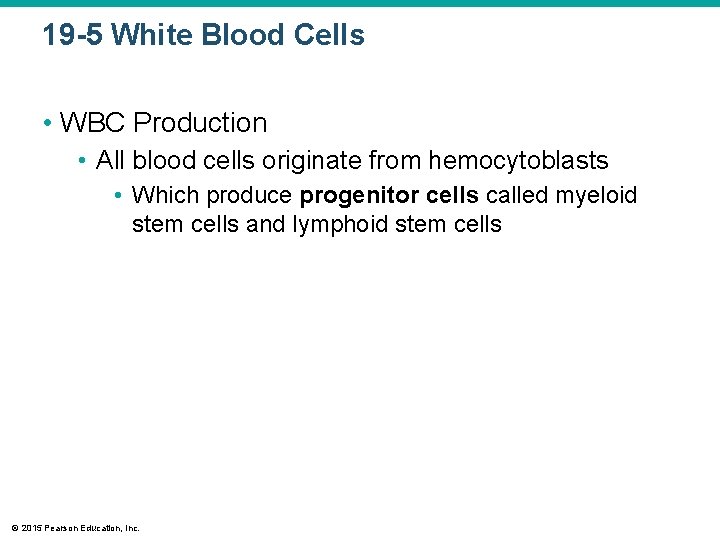
19 -5 White Blood Cells • WBC Production • All blood cells originate from hemocytoblasts • Which produce progenitor cells called myeloid stem cells and lymphoid stem cells © 2015 Pearson Education, Inc.
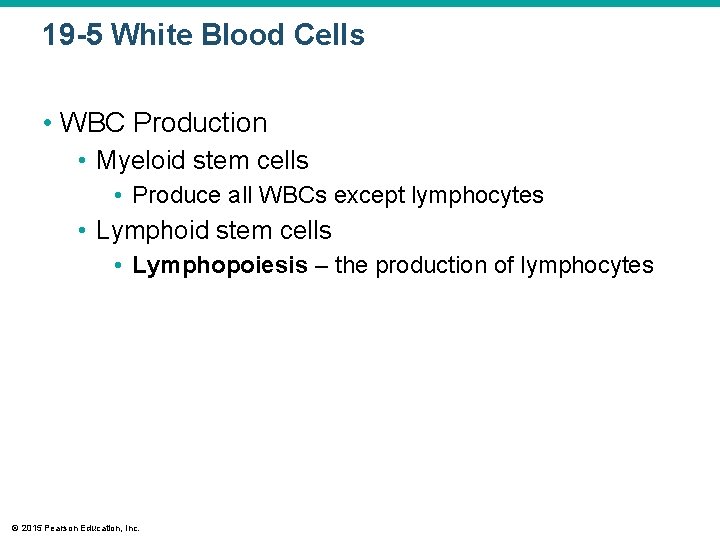
19 -5 White Blood Cells • WBC Production • Myeloid stem cells • Produce all WBCs except lymphocytes • Lymphoid stem cells • Lymphopoiesis – the production of lymphocytes © 2015 Pearson Education, Inc.

19 -5 White Blood Cells • WBC Development • WBCs, except monocytes • Develop in bone marrow • Monocytes • Develop into macrophages in peripheral tissues © 2015 Pearson Education, Inc.
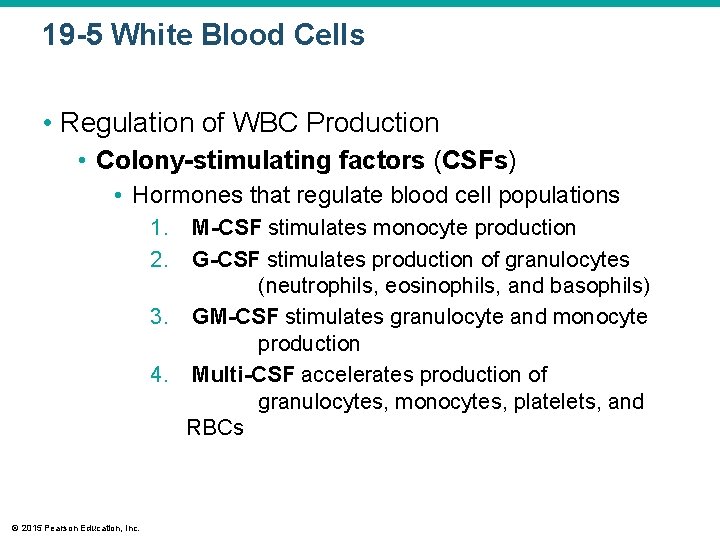
19 -5 White Blood Cells • Regulation of WBC Production • Colony-stimulating factors (CSFs) • Hormones that regulate blood cell populations 1. 2. M-CSF stimulates monocyte production G-CSF stimulates production of granulocytes (neutrophils, eosinophils, and basophils) 3. GM-CSF stimulates granulocyte and monocyte production 4. Multi-CSF accelerates production of granulocytes, monocytes, platelets, and RBCs © 2015 Pearson Education, Inc.

Table 19 -3 Formed Elements of the Blood (Part 2 of 4). © 2015 Pearson Education, Inc.
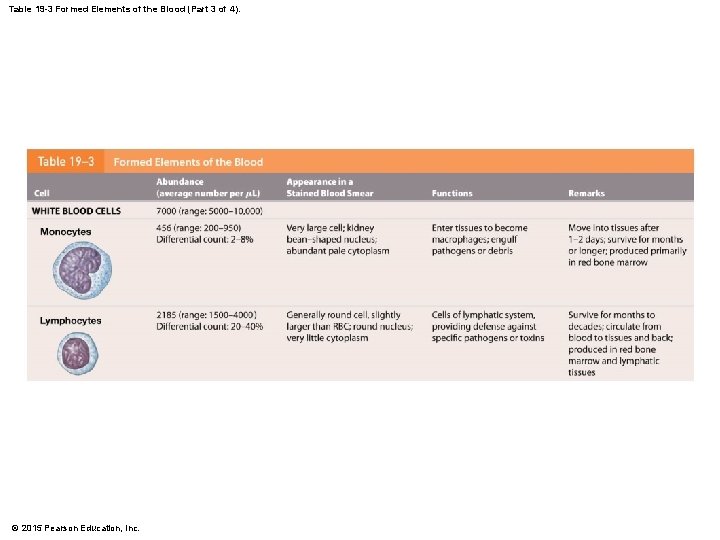
Table 19 -3 Formed Elements of the Blood (Part 3 of 4). © 2015 Pearson Education, Inc.
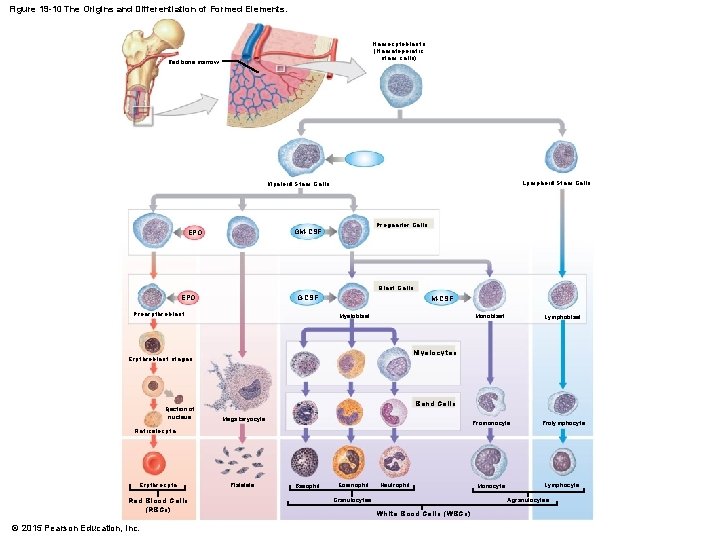
Figure 19 -10 The Origins and Differentiation of Formed Elements. Hemocytoblasts (Hematopoietic stem cells) Red bone marrow Lymphoid Stem Cells Myeloid Stem Cells Progenitor Cells GM-CSF EPO Blast Cells EPO G-CSF Proerythroblast M-CSF Myeloblast Monoblast Myelocytes Erythroblast stages Ejection of nucleus Lymphoblast Band Cells Megakaryocyte Promonocyte Prolymphocyte Monocyte Lymphocyte Reticulocyte Erythrocyte Red Blood Cells (RBCs) © 2015 Pearson Education, Inc. Platelets Basophil Eosinophil Neutrophil Agranulocytes Granulocytes White Bood Cells (WBCs)
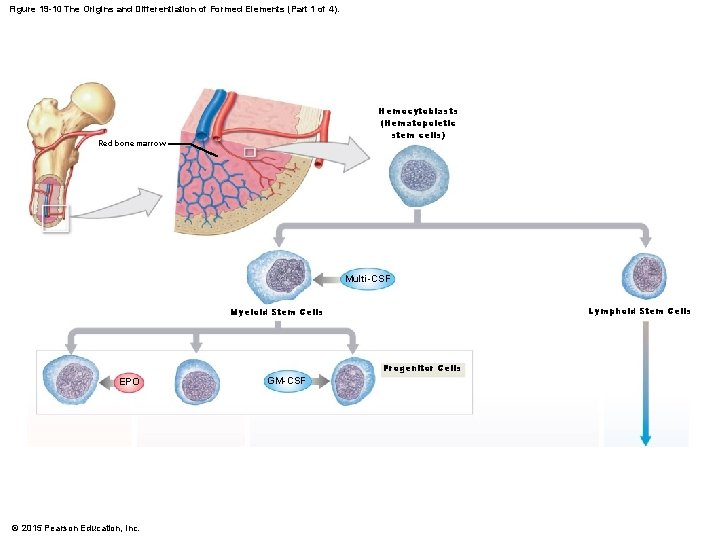
Figure 19 -10 The Origins and Differentiation of Formed Elements (Part 1 of 4). Hemocytoblasts (Hematopoietic stem cells) Red bone marrow Multi-CSF Lymphoid Stem Cells Myeloid Stem Cells Progenitor Cells EPO © 2015 Pearson Education, Inc. GM-CSF
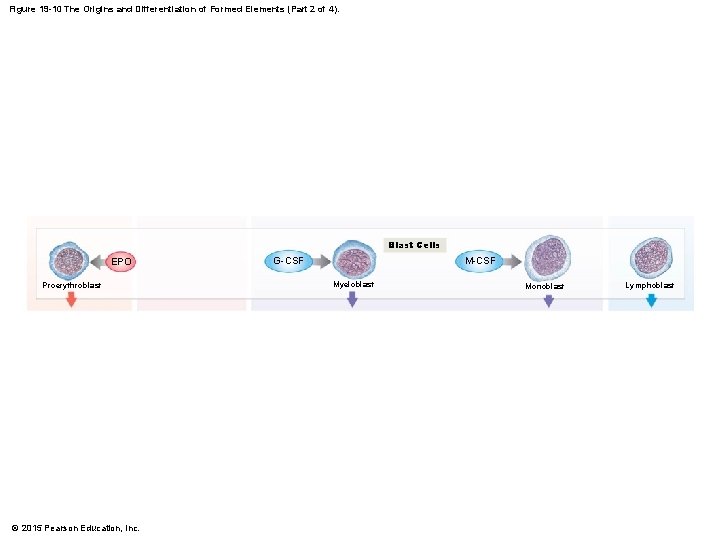
Figure 19 -10 The Origins and Differentiation of Formed Elements (Part 2 of 4). Blast Cells EPO Proerythroblast © 2015 Pearson Education, Inc. G-CSF Myeloblast Monoblast Lymphoblast
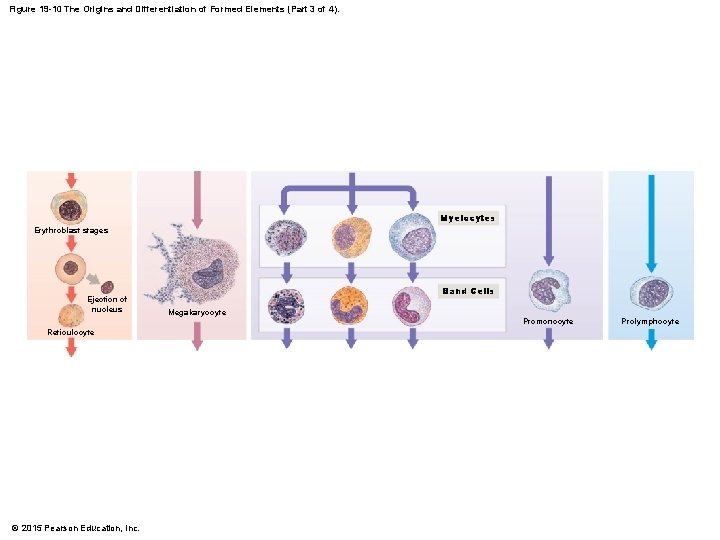
Figure 19 -10 The Origins and Differentiation of Formed Elements (Part 3 of 4). Myelocytes Erythroblast stages Ejection of nucleus Reticulocyte © 2015 Pearson Education, Inc. Band Cells Megakaryocyte Promonocyte Prolymphocyte

Figure 19 -10 The Origins and Differentiation of Formed Elements (Part 4 of 4). Erythrocyte Red Blood Cells (RBCs) © 2015 Pearson Education, Inc. Platelets Basophil Eosinophil Neutrophil Granulocytes Monocyte Lymphocyte Agranulocytes White Blood Cells (WBCs)
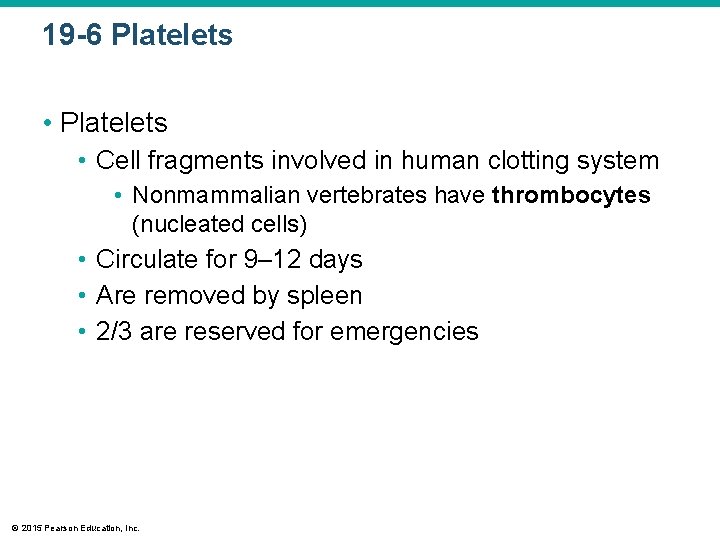
19 -6 Platelets • Cell fragments involved in human clotting system • Nonmammalian vertebrates have thrombocytes (nucleated cells) • Circulate for 9– 12 days • Are removed by spleen • 2/3 are reserved for emergencies © 2015 Pearson Education, Inc.
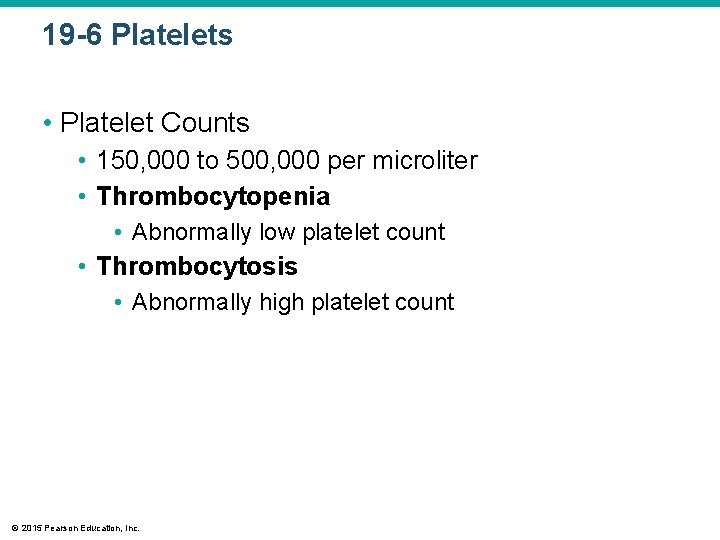
19 -6 Platelets • Platelet Counts • 150, 000 to 500, 000 per microliter • Thrombocytopenia • Abnormally low platelet count • Thrombocytosis • Abnormally high platelet count © 2015 Pearson Education, Inc.
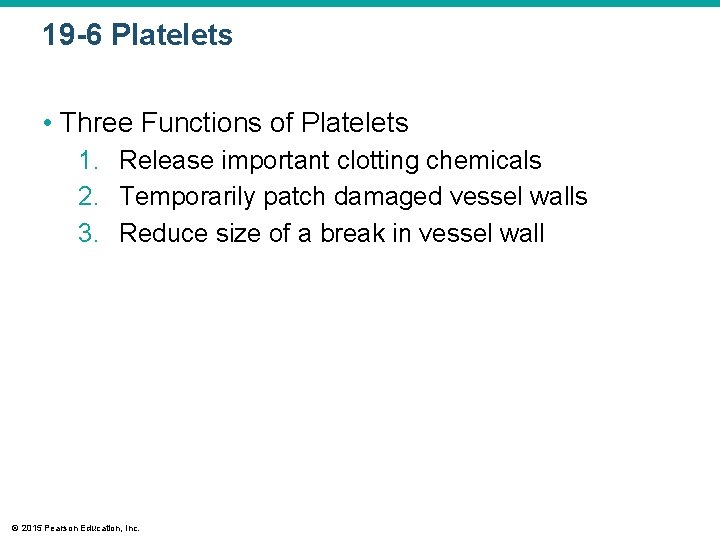
19 -6 Platelets • Three Functions of Platelets 1. Release important clotting chemicals 2. Temporarily patch damaged vessel walls 3. Reduce size of a break in vessel wall © 2015 Pearson Education, Inc.
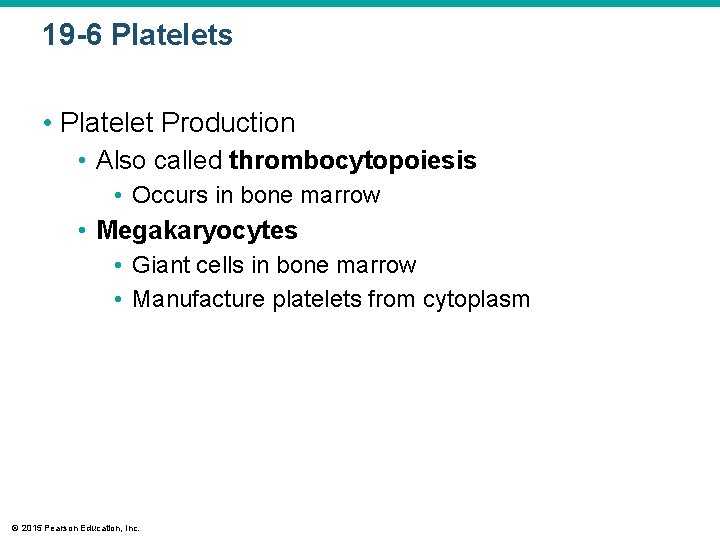
19 -6 Platelets • Platelet Production • Also called thrombocytopoiesis • Occurs in bone marrow • Megakaryocytes • Giant cells in bone marrow • Manufacture platelets from cytoplasm © 2015 Pearson Education, Inc.
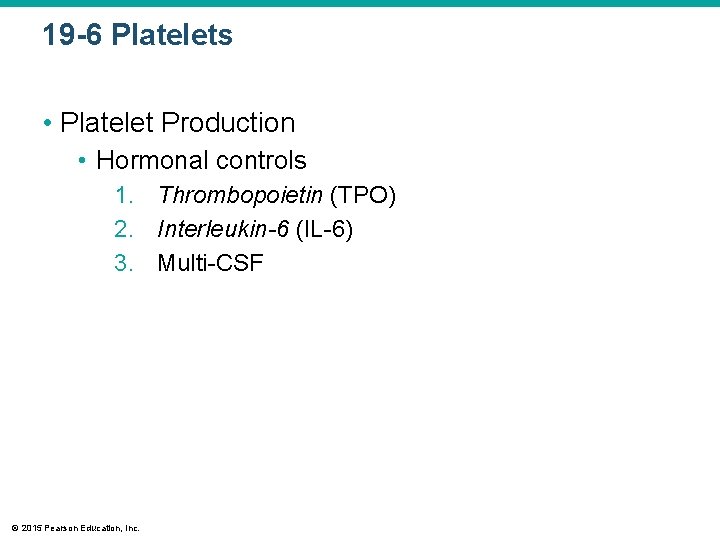
19 -6 Platelets • Platelet Production • Hormonal controls 1. Thrombopoietin (TPO) 2. Interleukin-6 (IL-6) 3. Multi-CSF © 2015 Pearson Education, Inc.
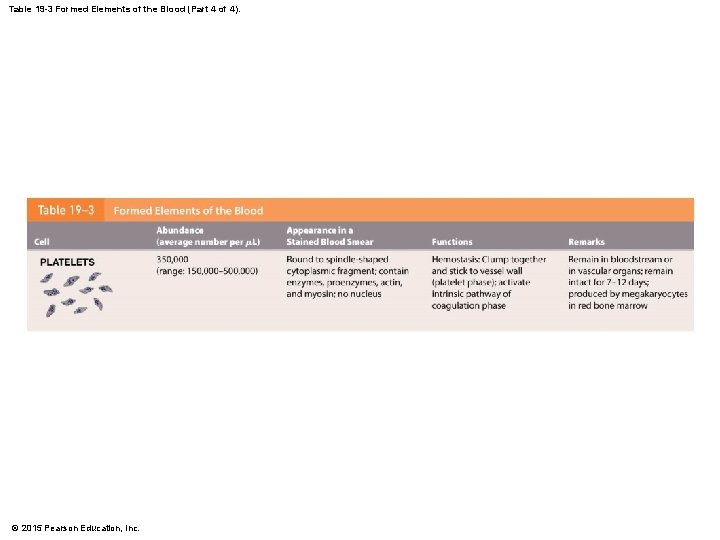
Table 19 -3 Formed Elements of the Blood (Part 4 of 4). © 2015 Pearson Education, Inc.

19 -7 Hemostasis • Is the cessation of bleeding • Consists of three phases 1. Vascular phase 2. Platelet phase 3. Coagulation phase © 2015 Pearson Education, Inc.
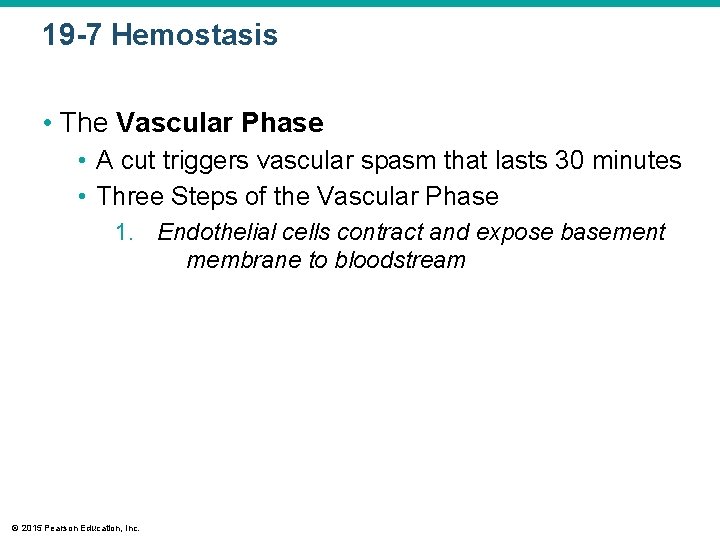
19 -7 Hemostasis • The Vascular Phase • A cut triggers vascular spasm that lasts 30 minutes • Three Steps of the Vascular Phase 1. Endothelial cells contract and expose basement membrane to bloodstream © 2015 Pearson Education, Inc.
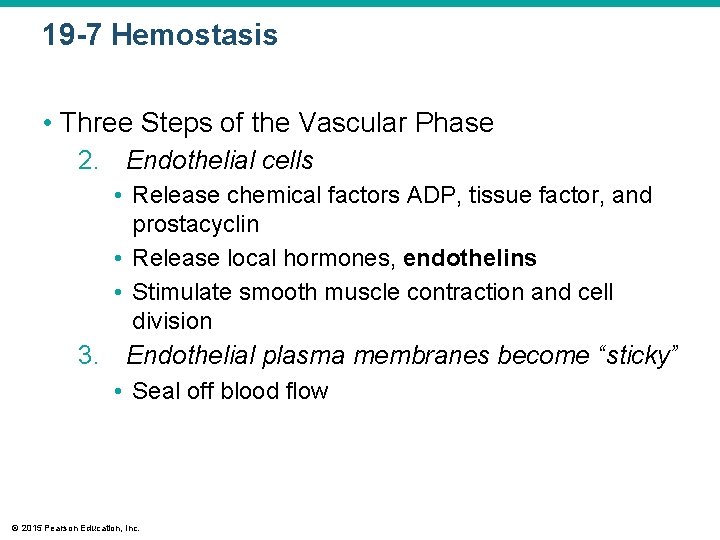
19 -7 Hemostasis • Three Steps of the Vascular Phase 2. Endothelial cells • Release chemical factors ADP, tissue factor, and prostacyclin • Release local hormones, endothelins • Stimulate smooth muscle contraction and cell division 3. Endothelial plasma membranes become “sticky” • Seal off blood flow © 2015 Pearson Education, Inc.
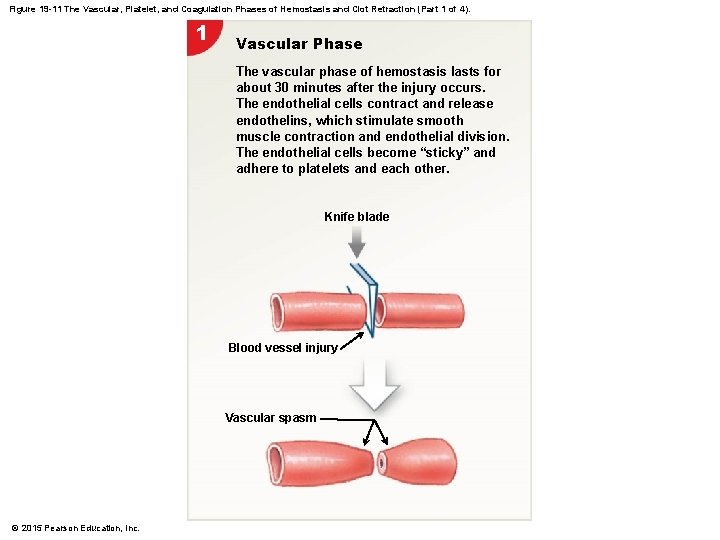
Figure 19 -11 The Vascular, Platelet, and Coagulation Phases of Hemostasis and Clot Retraction (Part 1 of 4). 1 Vascular Phase The vascular phase of hemostasis lasts for about 30 minutes after the injury occurs. The endothelial cells contract and release endothelins, which stimulate smooth muscle contraction and endothelial division. The endothelial cells become “sticky” and adhere to platelets and each other. Knife blade Blood vessel injury Vascular spasm © 2015 Pearson Education, Inc.
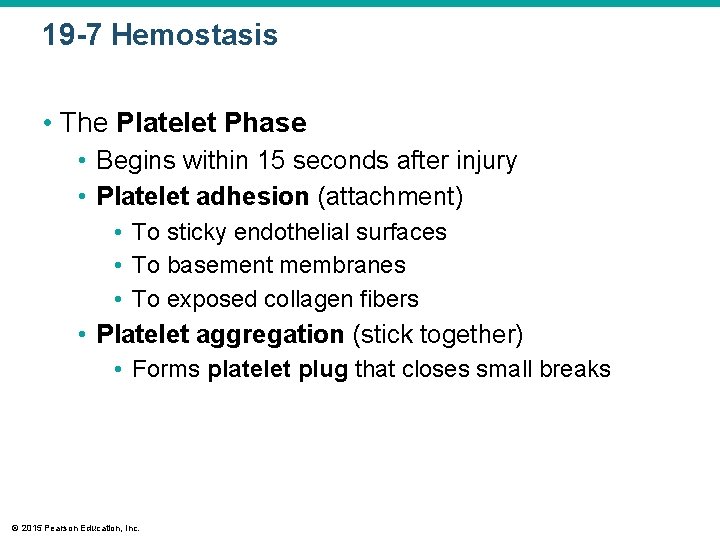
19 -7 Hemostasis • The Platelet Phase • Begins within 15 seconds after injury • Platelet adhesion (attachment) • To sticky endothelial surfaces • To basement membranes • To exposed collagen fibers • Platelet aggregation (stick together) • Forms platelet plug that closes small breaks © 2015 Pearson Education, Inc.
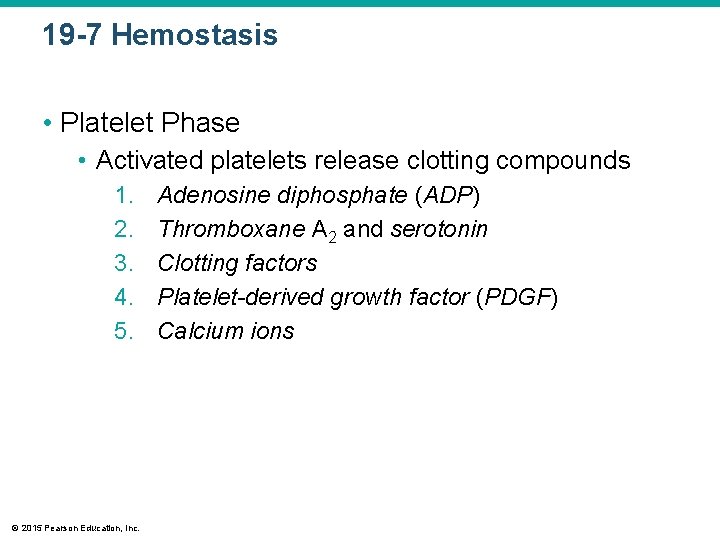
19 -7 Hemostasis • Platelet Phase • Activated platelets release clotting compounds 1. 2. 3. 4. 5. © 2015 Pearson Education, Inc. Adenosine diphosphate (ADP) Thromboxane A 2 and serotonin Clotting factors Platelet-derived growth factor (PDGF) Calcium ions
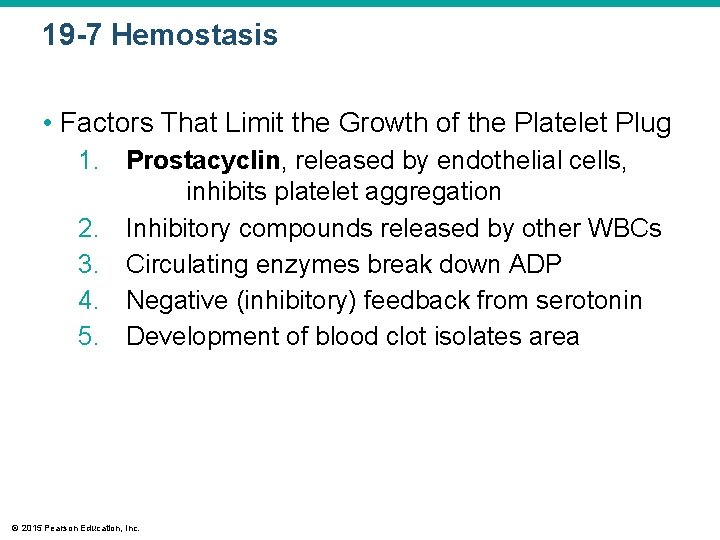
19 -7 Hemostasis • Factors That Limit the Growth of the Platelet Plug 1. Prostacyclin, released by endothelial cells, inhibits platelet aggregation 2. Inhibitory compounds released by other WBCs 3. Circulating enzymes break down ADP 4. Negative (inhibitory) feedback from serotonin 5. Development of blood clot isolates area © 2015 Pearson Education, Inc.

Figure 19 -11 The Vascular, Platelet, and Coagulation Phases of Hemostasis and Clot Retraction (Part 2 of 4). 2 Platelet Phase The platelet phase of hemostasis begins with the attachment of platelets to sticky endothelial surfaces, to the basement membrane, to exposed collagen fibers, and to each other. As they become activated, platelets release a variety of chemicals that promote aggregation, vascular spasm, clotting, and vessel repair. Plasma in vessel lumen Release of chemicals (ADP, PDGF, Ca 2+, platelet factors) Platelet aggregation Endothelium Platelet adhesion to damaged vessel Basement membrane Vessel wall Contracted smooth muscle cells Platelet plug may form Interstitial fluid © 2015 Pearson Education, Inc. Cut edge of vessel wall
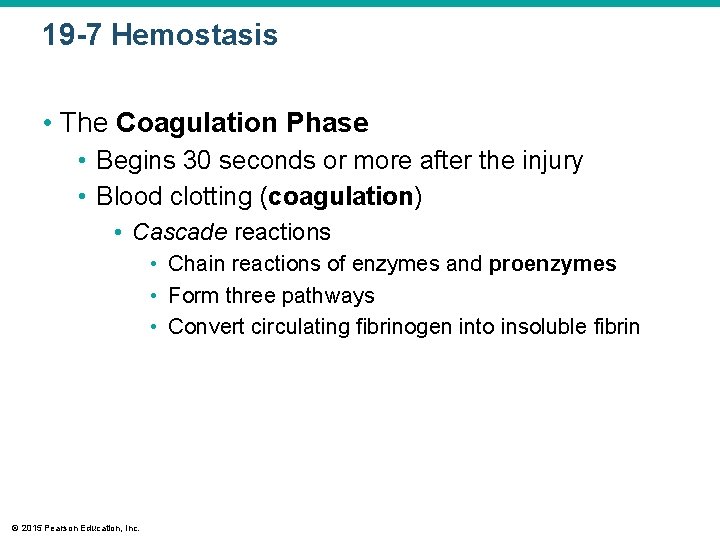
19 -7 Hemostasis • The Coagulation Phase • Begins 30 seconds or more after the injury • Blood clotting (coagulation) • Cascade reactions • Chain reactions of enzymes and proenzymes • Form three pathways • Convert circulating fibrinogen into insoluble fibrin © 2015 Pearson Education, Inc.
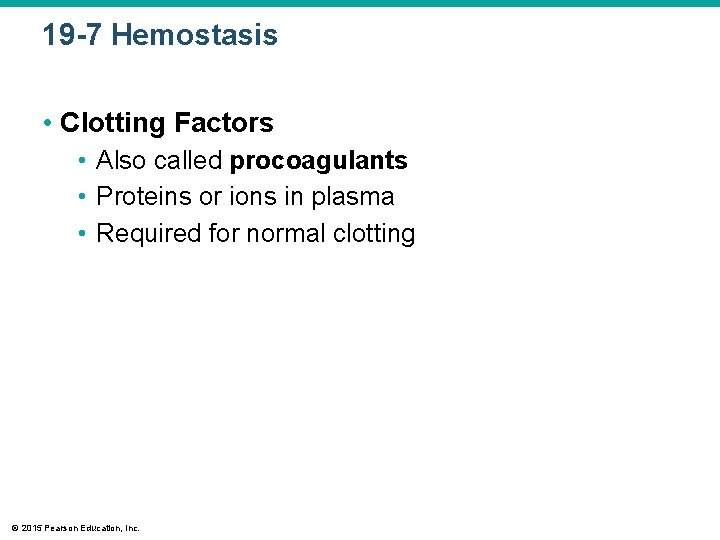
19 -7 Hemostasis • Clotting Factors • Also called procoagulants • Proteins or ions in plasma • Required for normal clotting © 2015 Pearson Education, Inc.
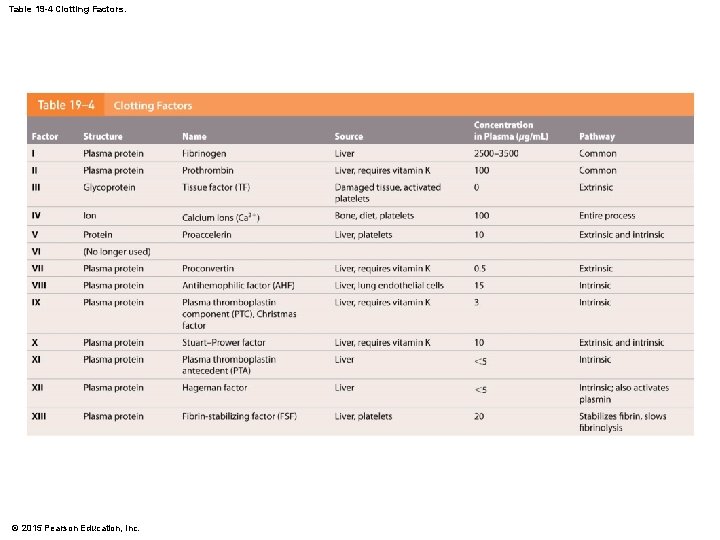
Table 19 -4 Clotting Factors. © 2015 Pearson Education, Inc.
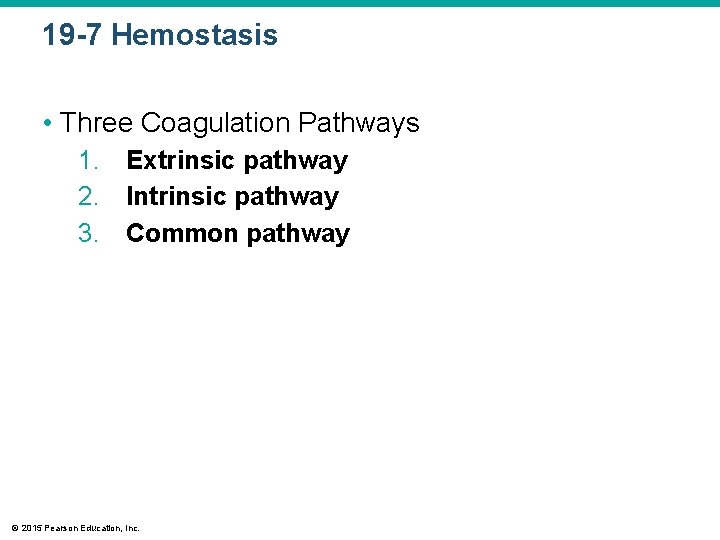
19 -7 Hemostasis • Three Coagulation Pathways 1. Extrinsic pathway 2. Intrinsic pathway 3. Common pathway © 2015 Pearson Education, Inc.
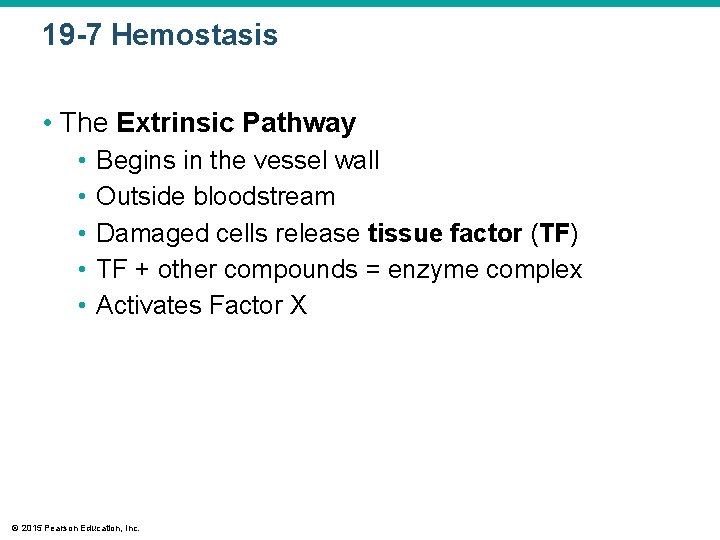
19 -7 Hemostasis • The Extrinsic Pathway • • • Begins in the vessel wall Outside bloodstream Damaged cells release tissue factor (TF) TF + other compounds = enzyme complex Activates Factor X © 2015 Pearson Education, Inc.
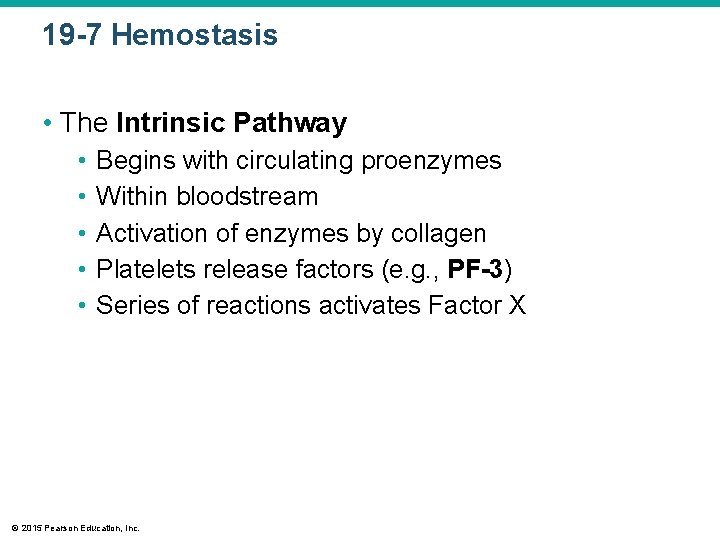
19 -7 Hemostasis • The Intrinsic Pathway • • • Begins with circulating proenzymes Within bloodstream Activation of enzymes by collagen Platelets release factors (e. g. , PF-3) Series of reactions activates Factor X © 2015 Pearson Education, Inc.
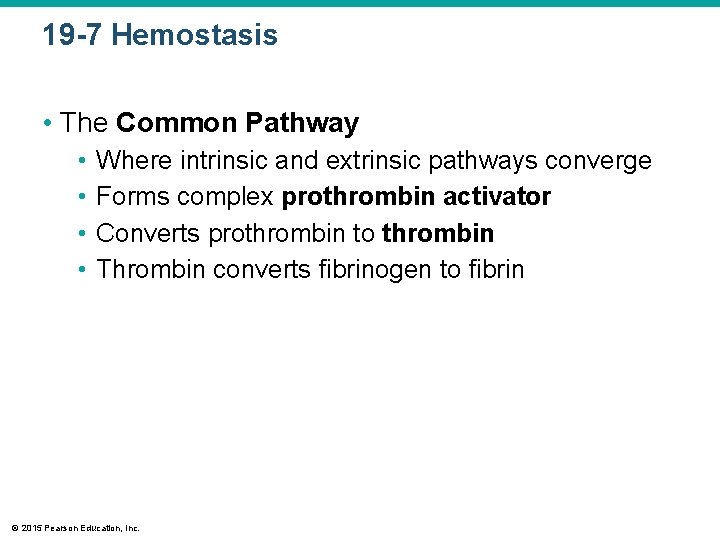
19 -7 Hemostasis • The Common Pathway • • Where intrinsic and extrinsic pathways converge Forms complex prothrombin activator Converts prothrombin to thrombin Thrombin converts fibrinogen to fibrin © 2015 Pearson Education, Inc.
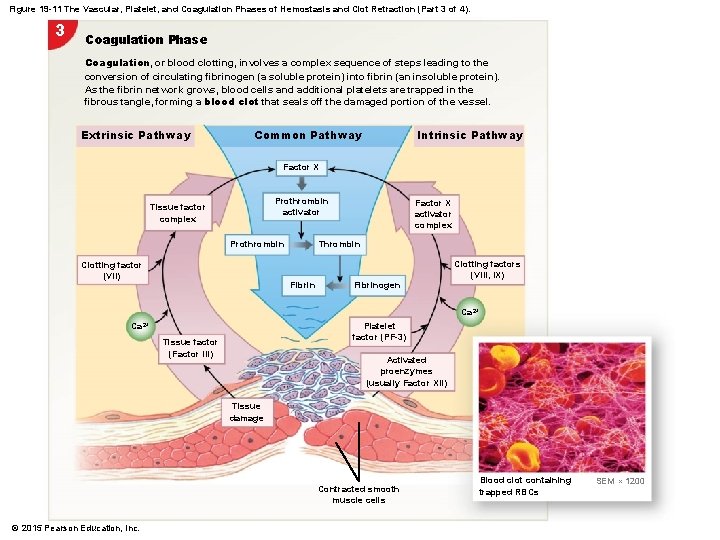
Figure 19 -11 The Vascular, Platelet, and Coagulation Phases of Hemostasis and Clot Retraction (Part 3 of 4). 3 Coagulation Phase Coagulation, or blood clotting, involves a complex sequence of steps leading to the conversion of circulating fibrinogen (a soluble protein) into fibrin (an insoluble protein). As the fibrin network grows, blood cells and additional platelets are trapped in the fibrous tangle, forming a blood clot that seals off the damaged portion of the vessel. Extrinsic Pathway Common Pathway Intrinsic Pathway Factor X Prothrombin activator Tissue factor complex Prothrombin Clotting factor (VII) Factor X activator complex Thrombin Fibrinogen Clotting factors (VIII, IX) Ca 2+ Platelet factor (PF-3) Ca 2+ Tissue factor (Factor III) Activated proenzymes (usually Factor XII) Tissue damage Contracted smooth muscle cells © 2015 Pearson Education, Inc. Blood clot containing trapped RBCs SEM × 1200
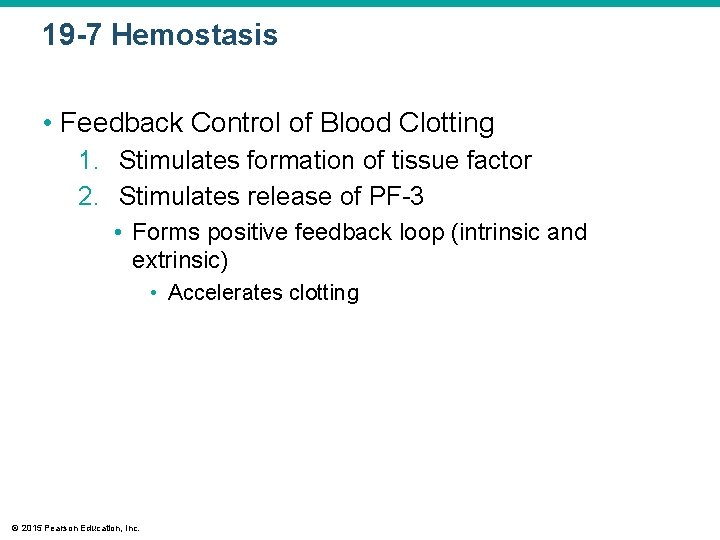
19 -7 Hemostasis • Feedback Control of Blood Clotting 1. Stimulates formation of tissue factor 2. Stimulates release of PF-3 • Forms positive feedback loop (intrinsic and extrinsic) • Accelerates clotting © 2015 Pearson Education, Inc.
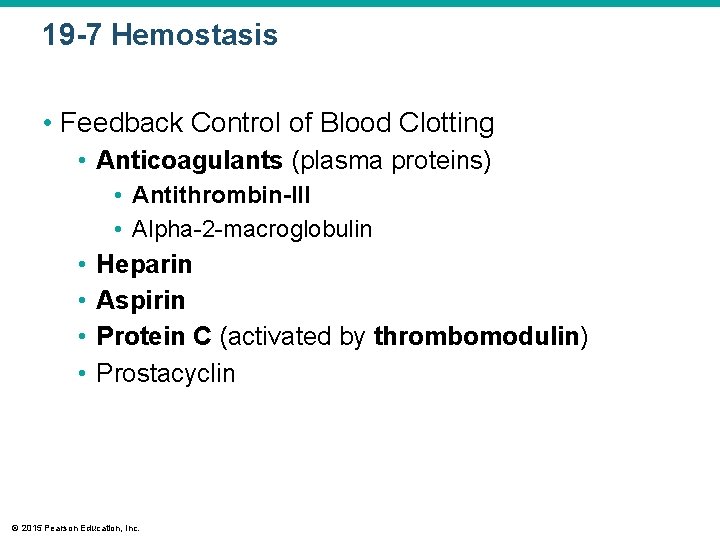
19 -7 Hemostasis • Feedback Control of Blood Clotting • Anticoagulants (plasma proteins) • Antithrombin-III • Alpha-2 -macroglobulin • • Heparin Aspirin Protein C (activated by thrombomodulin) Prostacyclin © 2015 Pearson Education, Inc.
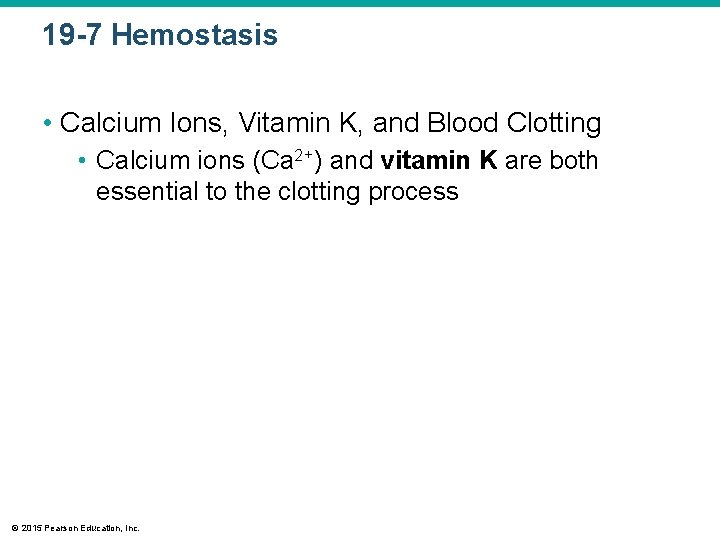
19 -7 Hemostasis • Calcium Ions, Vitamin K, and Blood Clotting • Calcium ions (Ca 2+) and vitamin K are both essential to the clotting process © 2015 Pearson Education, Inc.
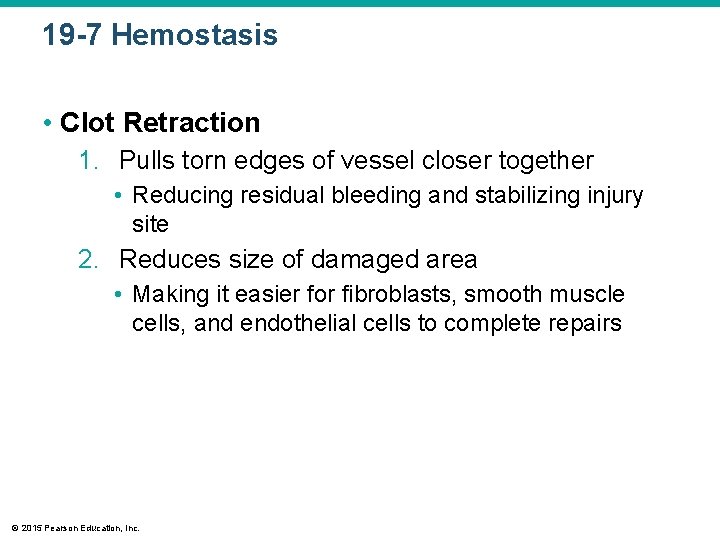
19 -7 Hemostasis • Clot Retraction 1. Pulls torn edges of vessel closer together • Reducing residual bleeding and stabilizing injury site 2. Reduces size of damaged area • Making it easier for fibroblasts, smooth muscle cells, and endothelial cells to complete repairs © 2015 Pearson Education, Inc.
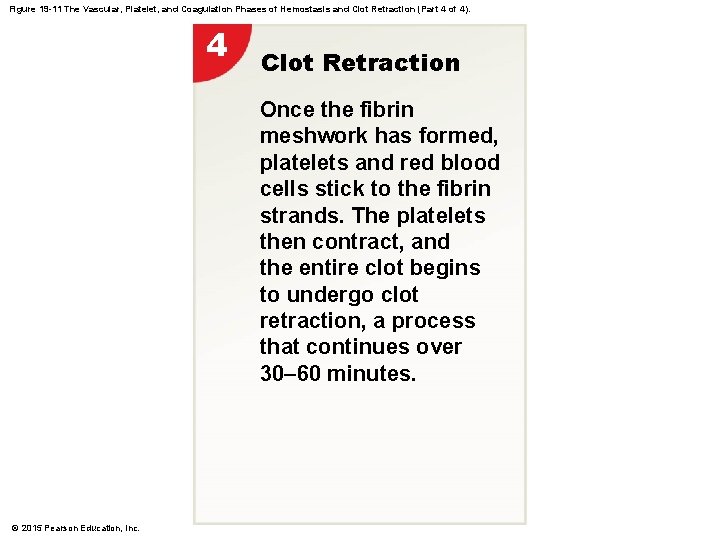
Figure 19 -11 The Vascular, Platelet, and Coagulation Phases of Hemostasis and Clot Retraction (Part 4 of 4). 4 Clot Retraction Once the fibrin meshwork has formed, platelets and red blood cells stick to the fibrin strands. The platelets then contract, and the entire clot begins to undergo clot retraction, a process that continues over 30– 60 minutes. © 2015 Pearson Education, Inc.

19 -7 Hemostasis • Fibrinolysis • Slow process of dissolving clot • Thrombin and tissue plasminogen activator (t-PA) • Activate plasminogen • Plasminogen produces plasmin • Digests fibrin strands © 2015 Pearson Education, Inc.
- Slides: 113